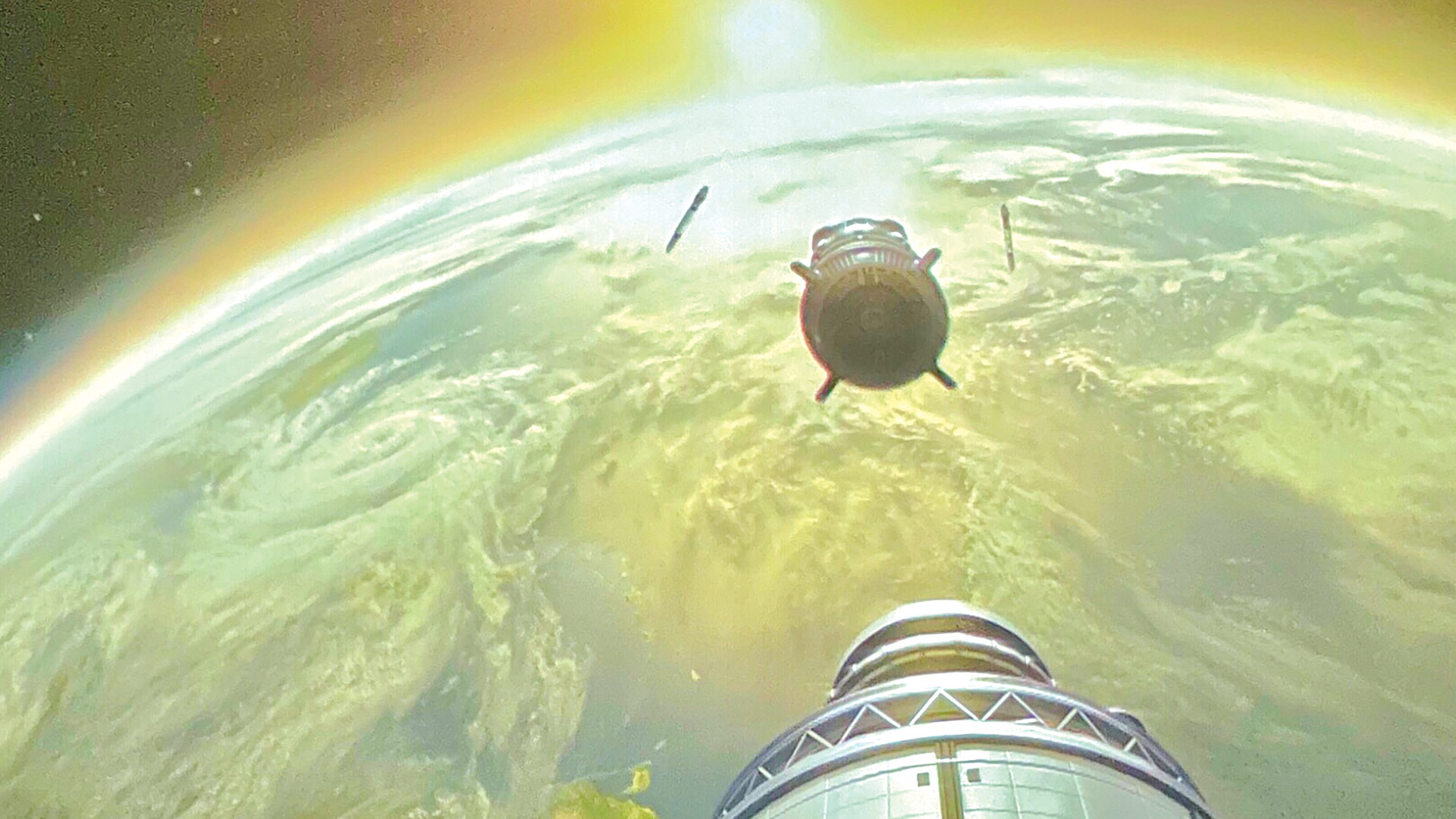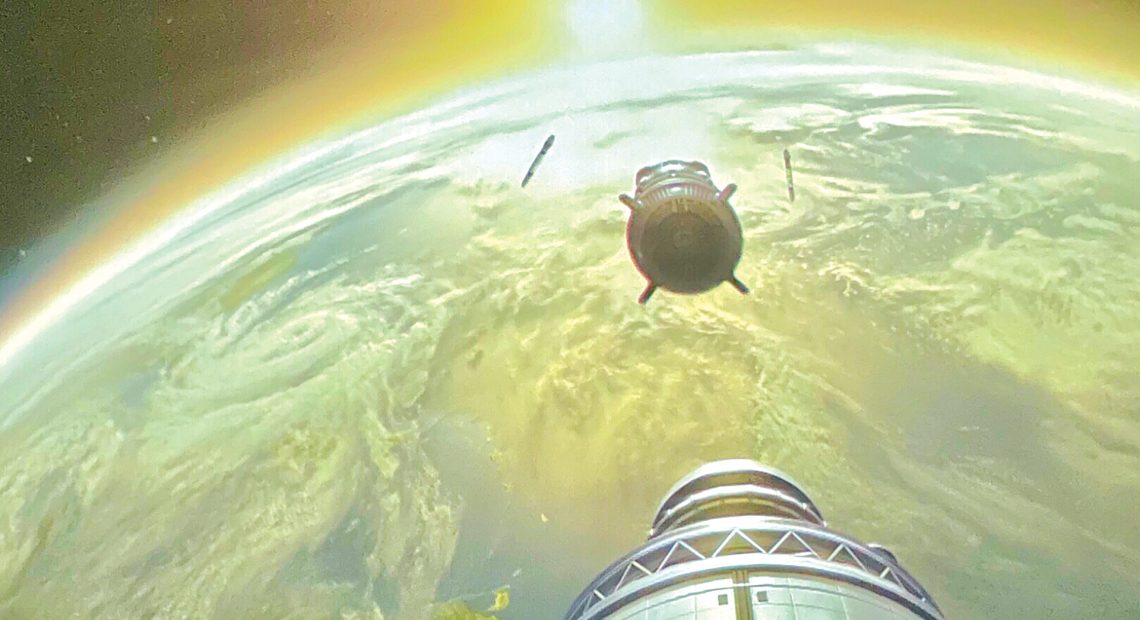The Sky’s the Limit

For a few minutes on April 28, if you were looking for a gaggle of local lawmakers and Springfield Museums board members, you’d have to look beyond earth, because they were traveling through space.
At least, they felt like they were.
That’s the idea, anyway, and it’s becoming reality thanks to the addition of a state-of-the-art Zeiss Velvet full-dome projector in the Seymour Planetarium, which will provide a fully immersive, 3D experience for visitors to the Springfield Science Museum. The planetarium opened to the public with the new system on April 29, the day after legislators and museum supporters got a tour.
“Our new projector creates an incredibly immersive experience,” said Jenny Powers, director of the Science Museum. “We hope that even more in-depth learning will happen when our visitors feel that they are traveling through part of our universe.”
The planetarium’s venerable Korkosz star ball — in continuous operation since 1937 — is not being replaced; in fact, it works in tandem with the Zeiss projector to create a more detailed, realistic virtual journey through the cosmos.
Meanwhile, just down the hall from the planetarium, a newly upgraded, interactive International Space Station exhibit will provide visitors with a better understanding of what it takes (and what it’s like) to fly among the stars, living and working in outer space for months on end. That improved exhibit also opened on April 29.
“In addition to the educational value of these improvements for schools and workforce development, the dynamic additions to the Science Museum will help drive tourism and generate critical economic development for the region.”
Taken together, these improvements — and others throughout the Science Museum — represent a $750,000 investment made possible through private donations as well as support from the Massachusetts Office of Travel and Tourism and a partnership with the National Aeronautics and Space Administration under a federal earmark sponsored by U.S. Sens. Edward Markey and Elizabeth Warren.
Kay Simpson, president and CEO of the Springfield Museums, said these projects are major steps toward the goal of making the museums the premier STEM learning center of the region.
“Today is historic,” she told the gathered guests the day before the new exhibits opened. “The story starts back in 1934 to 1937, when the Korkosz brothers of Chicopee made a star-ball projector by hand for the Seymour Planetarium. And they did this because it was the Depression and the museum could not afford a state-of-the-art Zeiss projection system. That being said, this star-ball projector was a marvel of innovation and invention. And it entertained such celebrities as movie star Clark Gable, who actually saw a live show in the planetarium in 1939.”
Fast-forward to 2022, and the museum was still using what had become the oldest operating star ball, not just in the country, but in the world, she added.
“So we’re very, very proud of our antique star ball, but we knew that we could do so much more to teach children and families about the wonders of the universe and really provide high-quality STEM learning experiences for students,” Simpson said. “So we’re fortunate that we were able to receive funding through federal and state earmarks so we could finally purchase the state-of-the-art Zeiss projector that we could not afford back in 1934. We have come full circle, and we are so excited about what is happening.”
The Final Frontier
In 2018, Simpson explained, the Springfield Museums launched its Evolution Campaign, which was designed to make the Science Museum a 21st-century, state-of-the-art attraction.
“In addition to the educational value of these improvements for schools and workforce development, the dynamic additions to the Science Museum will help drive tourism and generate critical economic development for the region,” she said.
Simpson emphasized the public and private support for the project, which has drawn on state and federal earmarks and leveraged funding from private foundations and individuals as well.
“So, needless to say, this is just an incredible moment for the Science Museum and a major investment in amplifying our importance as an educational resource for students and also a must-see tourist attraction. And I think we are really doing great work on both fronts.

Kay Simpson celebrates the opening of the upgraded planetarium alongside (from left) state Rep. Carlos Gonzalez, state Sen. Jake Oliveira, and Darryl Williams from the office of state Rep. Bud Williams.
“We all know that the education for our children is essential for workforce development,” she added. “We hear a lot about educational equity. Museums are playing a role in all of that. And tourism, as we all know, is a major economic driver in Western Massachusetts.”
State Rep. Carlos Gonzalez agreed. “We know the importance of tourism; we know the importance of these destinations,” he said. “Having these locations to bring people from across the world to visit is so critical and important. But also, for the community and city of Springfield to come and embrace the educational opportunities that they have here is so great.”
State Sen. Jake Oliveira agreed. “Tourism is our third-largest industry, and it is so important for the Pioneer Valley, and the Springfield Museums have played such a critical role in that.”
He added that he was pleased to attend the legislative visit as someone who has always loved outer space. In fact, he recalled visiting the Springfield Museums as a child, taking in the space exhibits, and dreaming of one day being an astronaut.
“That dream ended very quickly when I realized I’m afraid of heights, small places, and fires. So that dream ended very quickly,” Oliveira said. “But I’m so glad that so many families can explore the opportunities of space that we have here at the Springfield Museums — and going into a planetarium that can actually project the images of the Webb Space Telescope, which are some of the most beautiful images of our galaxy and beyond that we can see.”
Powers emphasized the potential the Seymour Planetarium will have in creating customized programs for local teachers and students.
“There are two different ways that we’re going to be able to serve schools,” she said. “First of all, the planetarium shows have previews, and we’ve been able to embed them on our website so teachers can see them in advance and match the content of the show to what they need to teach their children. That’s really important.”
“The planetarium shows have previews, and we’ve been able to embed them on our website so teachers can see them in advance and match the content of the show to what they need to teach their children.”
In addition, Kevin Kopchynski, STEM curator for the Springfield Museums, can create custom shows for students, Powers explained.
“So if a teacher comes in from any level, from kindergarten up through college, and has a particular thing they need to focus on, Kevin can make them a show about that. It’s something that’s highly customizable.”
Also, for the first time ever, the planetarium will offer Spanish-language planetarium shows.
“We can do almost any kind of representation that we want to using this system,” Powers said. “The modern planetarium shows offer us such a greater diversity of people than the old ones do. That’s one way we can serve not only schools, but all of our visitors. We’re incredibly excited about that.
The Next Generation
Darryl Williams, district director for state Rep. Bud Williams, spoke at the legislative event and, like Oliveira, recalled fond early memories of the Science Museum.
“This is my favorite museum here in Springfield. I grew up going to this museum every summer; my parents made sure that we came here,” he said, noting that his parents also bought him a telescope to gaze at Mars and Venus and myriad constellations — and that he was inspired by learning about the accomplishments of scientists during his museum visits.
“I really enjoyed it, and I look forward to many, many more years,” he said, “and I look forward showing my grandkids this one day.”
That’s the kind of legacy the Springfield Science Museum and its Seymour Planetarium has cultivated for generations, and will continue to cultivate — only now, in much sharper detail.






